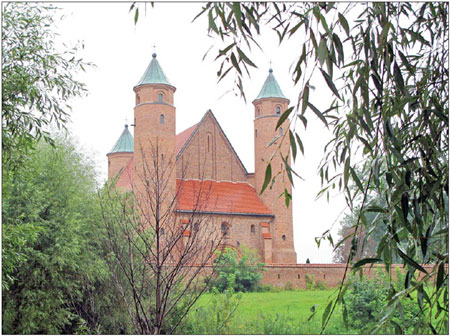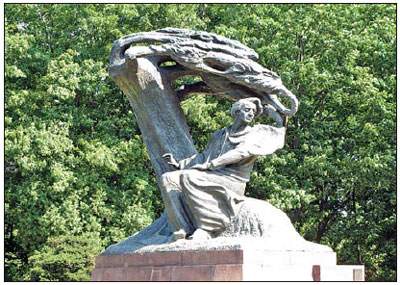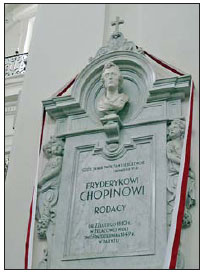Warsaw’s music man
|
Chopin spent almost half his life in Warsaw and many visitors now come to trace the composer's footsteps. Photos by Lin Ling / For China Daily |
|
A bronze sculpture at Royal Lazienki Park shows the composer sitting under a windblown willow. |
|
Holy Cross Church is home to Chopin's heart. |
Chen Jie gets up close and personal with Frederic Chopin in the composer's favorite city.
It is not a good start when you travel halfway across the globe to cover a Chopin festival and end up at the wrong concert in the wrong concert hall. But it guarantees an unforgettable trip.
Despite this comedy of errors, my recent trip to Warsaw to cover Chopin and His Europe Festival gave me some special insights.
The Adam Mickiewicz Institute, which arranged my trip, gave me the ticket and the cab driver dropped me off at the Warsaw Philharmonic Concert Hall. I missed the interpreter and when we finally found each other, he told me I had attended the wrong concert.
So although I enjoyed a wonderful concert featuring Mozart, Rossini and Bellini's operatic arias, I missed the one I was supposed to attend - a jazz concert by a popular Polish band that had rearranged and improvised Chopin's melodies in a totally contemporary way.
The interpreter later told me it was common for two or more concerts to be held at the same venue, since the city has recently been host to many events commemorating the 200th anniversary of the country's most famous musician.
"Bach is old-fashioned; French people don't like Tchaikovsky and Italians dislike Mozart, but there is nobody in the world who does not love Chopin," says former Polish culture minister Waldemar Dabrowsky, now the general director of the Polish National Opera and also the chairman of the 2010 Official Chopin Year.
"Chopin is not only the one we Polish are proud of, but he is the legacy of the whole world. He is our window to the world as well a window into Poland from the outside," he says.
In his office at the Polish National Opera, Dabrowsky said the bicentennial of Chopin's birth is a good opportunity to attract more visitors to Poland. For that reason, the 2010 Chopin Year features not only concerts, congresses and the famous Chopin piano competition held every five years in Warsaw, but also a unique city tour called "Chopin's Warsaw". This is specially designed for tourists to follow in the composer's footsteps.
Chopin spent almost half his life in Warsaw. In October 1810, the 7-month-old Chopin came to the city from the small village of Zelazowa Wola with his family. He later studied music here, made friends, gave his first concerts and then established himself as a prodigy both at the keyboard and as a composer.
But the Warsaw Chopin knew turned to rubble during World War II and there is little that remains from his time. It is a sad situation and I cannot help asking my 28-year-old interpreter what the name Chopin means to young Poles.
"Chopin is someone far away in history. He is like a huge monument, and we only hear his music during special occasions on television," he said.
Dabrowsky says a poll in 2009 showed that most people know little about Chopin. Some 54 percent of Warsaw inhabitants aged 15 and above wrongly believed that the composer spent his youth in Zelazowa Wola. Only one in five correctly said "Warsaw", while 10 percent thought Chopin lived in Paris.
In order to bring the Polish composer closer to life, the city designed the "Chopin's Warsaw" tour to show where he lived, studied and socialized.
My tour started from Holy Cross Church, where Chopin's heart is interred. The musician had asked his sister to bring his heart home, a fact commonly known among the composer's Chinese fans.
The church was constructed at the end of the 17th century, and this was the Chopin family's parish church. His heart is placed inside the second pillar on the left side of the main nave.
Holy Cross Church is on Warsaw's Royal Route, where you can track the places Chopin lived or frequented. Along the street, there are multimedia "Chopin Benches", where you can plot a map of all the important places connected with the composer and press buttons to hear Chopin's mazurkas, polonaises and waltzes.
Walking south along the Royal Route, I was soon standing in front of the Tomb of the Unknown Soldier. This used to be the Saski Palace in Chopin's time, and his family lived in the right wing for seven years after they moved to Warsaw. The Saski Garden was Chopin's favorite playground during his childhood, and even after the family moved away, he often came back to linger.
It was also where he courted his high school sweetheart, soprano Konstancja Gladkowska.
Across the Royal Route is today's Warsaw University. In 1817, the Chopin family moved to a larger apartment located on the second floor in the Kazimierz Palace, which now houses the main office of Warsaw University.
Just outside the campus stands the Church of St. Joseph, one of the few buildings to have survived World War II undamaged. It is known for its Baroque faade, boat-shaped rococo pulpit and an ebony tabernacle in 1654 that resembles a small temple.
Chopin often played the church organ here at high school Masses, and it was at one such Mass he met Gladkowska, who sang a solo during the service.
Chopin's favorite cafe, Honoratka, was on Miodowa Street outside the campus. He visited the cafe every day where he joined youthful patriots talking about art, culture and politics. He also dropped into the nearby music shop owned by Antoni Brezina, the first person to publish his music. Now the cafe and the music store are gone but a restaurant named Honoratka stands at the corner of Miodowa and Kapitulna Street to remind people of the composer.
When Chopin left his homeland to go to Vienna and later Paris, all he took with him were a fistful of soil from his motherland, a diary with entries by his acquaintances and friends, his scores and letters of recommendation.
He never returned.
(China Daily 11/07/2010 page16)

















